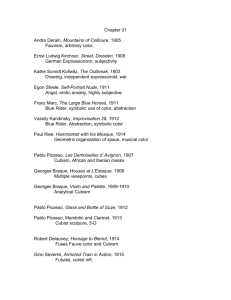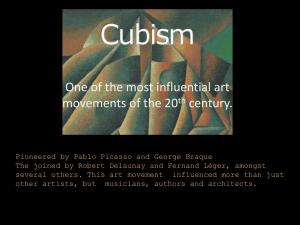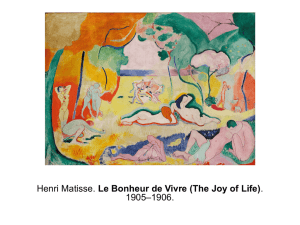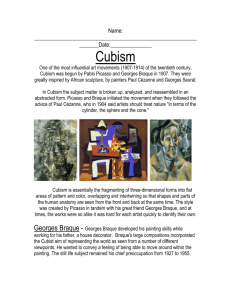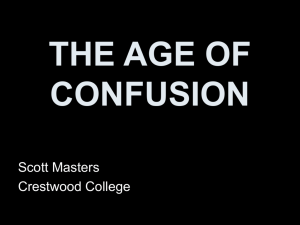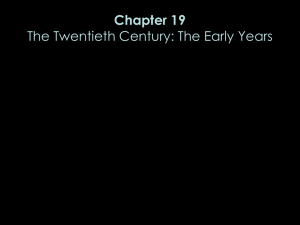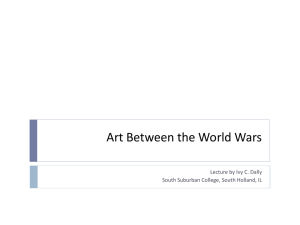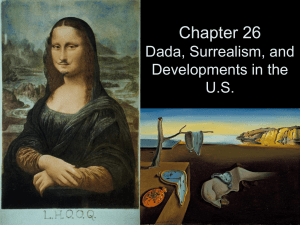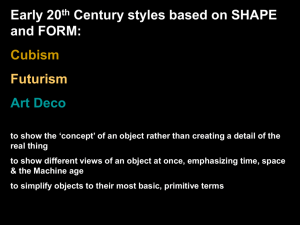Chapter 21: Between the World Wars
advertisement
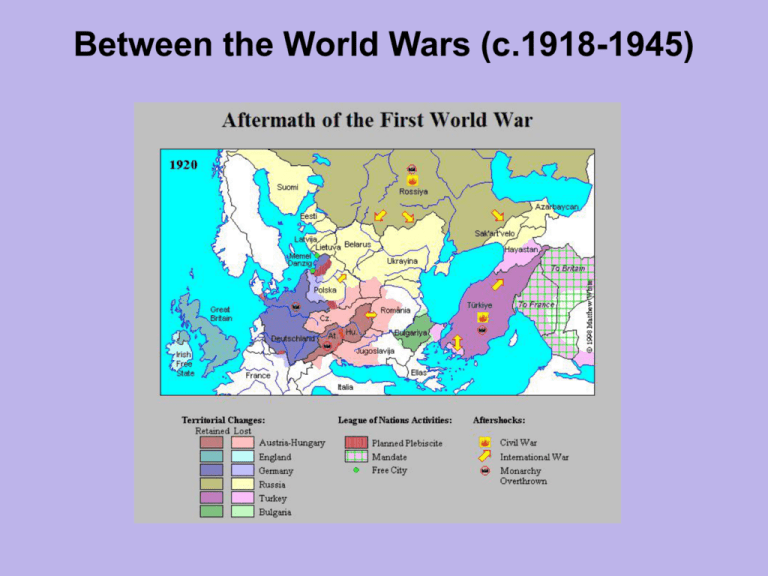
Between the World Wars (c.1918-1945) Chapter 21: BETWEEN THE World Wars OUTLINE Chapter 21: Between The World Wars The "Great War" and Its Significance Literary Modernism T. S. Eliot and James Joyce Franz Kafka Virginia Woolf The Revolution in Art: Cubism Freud, the Unconscious, and Surrealism The Age of Jazz George Gershwin Duke Ellington The Harlem Renaissance Ballet: Collaboration in Art Art as Escape: Dada Art as Protest: Guernica Art as Propaganda: Film Photography Art as Prophecy: From Futurism to Brave New World Outline Chapter 21 Timeline Chapter 21: Between the World Wars 1907 Picasso, Les Demoiselles d'Avignon c. 1911 German Expressionism; Kandinsky, Compositions 1915-1916 Dadaism; Duchamp, L.H.O.O.Q. 1919 Yeats, "The Second Coming" 1919 Bauhaus design school started at Weimar 1923 Chagall, Green Violinist 1924 Breton, First Surrealist Manifesto 1925 Eisenstein, Potemkin 1926 Kafka, The Castle 1928 Magritte, Man With a Newspaper 1931 Dali, The Persistence of Memory 1937 Hurston, Their Eyes Were Watching God 1937 Picasso, Guernica Timeline Chapter 21 The Terrible Impact of World War I What made World War I so terrible was the advanced technologies used in the service of death. The old military charge against an enemy was obsolete with the invention of the machine gun just as the use of poison gas (not outlawed until after the war) made a mockery of military exercises of strategy. The result was an appalling slaughter of youth on a scale unparalleled in human history. US Armored Cars - WWI US Tanks WWI Trench Warfare WWI The Cultural Responses to World War I In the period between the wars the memory of that slaughter shook intellectuals to the core. Their response to it was predictable enough: protest or pacifism or a total distrust of the powers of rationality to cope with human evil. The reaction to the Great War ranged, in short, from T. S. Eliot's combination of pessimism and faith to the playful nonsense of the dada artists and the inner retreat of the surrealists. Pablo Picasso Guernica, 1937 Dali, Salvador Soft Construction with Boiled Beans: Premonition of Civil War 1936 Technology in the Wake of World War The technological advances that had made the war so terrible also gave promise of new forms of communication that would radically advance the arts into new and different fields. The widespread development of radio networks, the transition of the movies from the silent screen to the "talkies," the increased mobility brought about by the automobile, and the advances in photography would not only produce new art forms but provide their availability to larger audiences Commercial and Amateur Wireless Radio Equipment 1910 - 1923 The Economic and Socio-Political Landscape Between the World Wars Coupled with these advances in technology were some profound shifts in social status. People were leaving rural areas in great numbers for the factories of the cities of America and Europe. The old social stratification of the classes was beginning to break down in Europe. The economic dislocations brought on by the war caused urban poverty in Europe and, after a giddy decade of prosperity in the 1920s, the depression years in the United States. White Angel Breadline 1933 By Dorthea Lange During the Great Depression, the destitute stood in breadlines like this one in San Francisco, set up by a wealthy woman known as the "White Angel." Dorothea Lange, "Migrant Mother," 1936 The New Politics of the Post WWI and pre-WWII World In response to these social and economic dislocations new political movements seemed attractive and compelling. Hitler's National Socialist party rose against the background of Germany's defeat, as did Mussolini's Fascists. The period between the wars also saw the consolidation of Communist power in Russia and the rise of the totalitarian state under Stalin. Scenes from Leni Riefenstahl's The Triumph of the Will 1935 Radical Shifts in Fundamental Thinking Finally, we should note some other fundamental (and radical) ideas that were beginning to gain currency. Einsteinian physics were changing the picture of the world in which we lived while containing the seeds of the atomic era. Sigmund Freud's ideas were also radically reshaping our notions of the interior landscape of the human soul. Albert Einstein, 1931 Sigmund Freud, 1938 …All of these forces - political, technological, scientific, social, and artistic - gave a shape to a culture that in its richness (and sadness) is called “the Western world between the two great wars”. Modernism as Exemplified by 20th Century Literature: The Second Coming -- W. B. Yeats, 1921 Turning and turning in the widening gyre The falcon cannot hear the falconer; Things fall apart; the centre cannot hold; Mere anarchy is loosed upon the world, The blood-dimmed tide is loosed, and everywhere The ceremony of innocence is drowned; The best lack all convictions, while the worst Are full of passionate intensity. Surely some revelation is at hand; Surely the Second Coming is at hand. The Second Coming! Hardly are those words out When a vast image out of Spiritus Mundi Troubles my sight: somewhere in sands of the desert A shape with lion body and the head of a man, A gaze blank and pitiless as the sun, Is moving its slow thighs, while all about it Reel shadows of the indignant desert birds. The darkness drops again; but now I know That twenty centuries of stony sleep Were vexed to nightmare by a rocking cradle, And what rough beast, its hour come round at last, Slouches towards Bethlehem to be born? William Butler Yeats 1923 Cubism: The Revolution in Art Cubism or cubism - One of the most influential art movements (1907-1914) of the twentieth century, Cubism was begun by Pablo Picasso (Spanish, 1882-1973) and Georges Braque (French, 1882-1963) in 1907. They were greatly inspired by African sculpture, by painters Paul Cézanne (French, 1839-1906) and Georges Seurat (French, 1859-1891), and by the Fauves. In Cubism the subject matter is broken up, analyzed, and reassembled in an abstracted form. Picasso and Braque initiated the movement when they followed the advice of Paul Cézanne, who in 1904 said artists should treat nature "in terms of the cylinder, the sphere and the cone.“ There were three phases in the development of Cubism: Facet Cubism, Analytic Cubism, and Synthetic Cubism. Georges Braque, Bottle, Newspaper, Pipe, and Glass, 1913, charcoal and various papers pasted on paper Pablo Picasso. Les Demoiselles d'Avignon. 1907 Marcel Duchamp Nude Descending a Staircase 1911-12 Georges Braque Georges Braque Fishing Boats 1909 Georges Braque Girl With a Cross 1911 Pablo Picasso Pablo Picasso (Spanish, 1881–1973) Girl Reading at a Table, 1934 The Old Guitarist, 1903/04 Oil on panel The Poet (Le Poète), August 1911 Dada: Art as a Critique of Civilization Dada or Dadaism [French, from dada, child's word for a horse] Nihilistic movement in the arts that flourished chiefly in France, Switzerland, and Germany from about 1916 to about 1920 and later and that was based on the principles of deliberate irrationality, anarchy, and cynicism and the rejection of laws of beauty and social organization. This was an intellectual reaction to the horrors of WWI, which revealed contemporary“civilized” man to be capable of brutality, savagery, and destructiveness on a scale unthinkable to previous generations. Coupled with the breakneck speed of technological “progress” and the radical paradigm shifts implied by Relativity and Freudianism, the artists of the immediate post-war period sought to encourage a revolution in consciousness by consciously subverting the underpinnings of civilized views of the world, such as language, rationality, and order in thought and social/political organization. After 1922, however, Dada faded and many Dadaists grew interested in surrealism. Dada Art Overturned Blue Shoe with Two Heels Under a Black Vault Very Rare Picture on the Earth 1915. Oil and metallic paint on board, and silver and gold leaf on wood Marcel Duchamp Fountain, 1917/1964 15 in. x 19 1/4 in. x 24 5/8 in. glazed ceramic with black paint Marcel Duchamp. Bicycle Wheel. 1951 Assemblage: metal wheel mounted on painted wood stool Marcel Duchamp The Work of Marcel Duchamp encompassed many of the trends of 20th-century art international movements from pre-cubism to conceptual art. In a way similar to the work of Pablo Picasso, Duchamp’s art can not be easily fit into a single category or “ism”. It illuminates the entire 20th-century landscape. L.H.O.O.Q., 1919 Nude, Sad Young Man on a Train, 1911–12. Oil on cardboard The Bride Stripped Bare by Her Bachelors, Even (The Large Glass) 1915-23 Oil, varnish, lead foil, lead wire, and dust on two glass panels, Philadelphia Museum of Art Surrealism: Freud and the Unconscious Surrealism is a style in which fantastic visual imagery from the subconscious mind is used with no intention of making the artwork logically comprehensible. Founded by Andre Breton in 1924, it was a primarily European movement which attracted many members of the chaotic Dada movement. It was similar in some respects to the late 19th-century Symbolist movement, but deeply influenced by the psychoanalytic work of Freud and Jung. The Surrealist circle was made up of many of the great artists of the 20th century, including Jean Arp, Max Ernst, Giorgio de Chirico, Man Ray, Joan Miro, and Rene Magritte. Salvador Dali, probably the single best-known Surrealist artist, was somewhat of an outsider due to his right-wing politics – during this period leftism was fashionable among Surrealists, in fact in almost all intellectual circles. Marc Chagall Paris Through the Window 1913 Oil on canvas Jean Arp Plastron et fourchette - Shirtfront and fork c.1922, painted wood Man Ray Rayograph c. 1925 Rayograph 1922 Salvador Dali The Persistence of Memory. 1931 Birth of Liquid Desires 1931–32. Oil and collage on canvas The Accommodations of Desire, 1929 Oil and cut-and-pasted printed paper on cardboard Rene Magritte The Reckless Sleeper 1928 Le Dormeur téméraire Oil on canvas A figure sleeps in a wooden alcove or box above a dark cloudy sky. The way into this space is barred by a tablet embedded with everyday objects, which are displayed as in a book for children. As Magritte knew, some or all of them could also be read as Freudian symbols. This combination of different possible interpretations adds to the painting’s suggestion of dream-like unease and disorientation. “The Betrayal of Images" (1928-9) Max Ernst Attirement of the Bride (La Toilette de la mariée), 1940. Oil on canvas The Antipope, December 1941–March 1942 Oil on canvas Giorgio de Chirico The Red Tower 1913. Oil on canvas The Melancholy of Departure 1914 The Enigma of a Day 1914 Yves Tanguy Indefinite Divisibility 1942 Paul Delvaux Sleeping Venus 1944 Joan Miró Landscape (The Hare) autumn 1927 Oil on canvas Paul Klee Red Balloon, 1922. Oil on chalk-primed gauze, mounted on board, 12 1/2 x 12 1/4 inches. The Jazz Age and The Harlem Renaissance In the decade following World War I, an artistic explosion occurred predominantly within the African American community that produced a wealth of music, literature poetry, dance, social discourse and visual art. Quickly, this music and culture broadened its base to include practitioners and audiences of all races, ages, and socio-economic groups and entered mainstream American culture, where it became truly, a mass-media, cross-cultural, and global phenomenon. Tales of the Jazz Age (1922) F. Scott Fitzgerald Dust Jacket Illustration by John Held, Jr. The William P. Gottlieb Collection, comprising over sixteen hundred photographs of celebrated jazz artists, documents the jazz scene from 1938 to 1948 Art as Propoganda: Film Sergei Eisenstein. Potemkin 1925 35mm film, black and white and hand-colored, silent, about 75 minutes Early- to Mid-20th Century Photography Brassai Backstage at the Folies-Bergere 1933 Man Ray The Gift Date: 1921 ANSEL ADAMS Monolith, Face of Half Dome, 1927 Futurism to “Brave New World” : Art as Prophecy Sea=Dancer 1914 Oil on canvas Aldous Huxley Brave New World (1931) Toward the Dawn of the New Age The mushroom cloud of the atomic bombing of Nagasaki, Japan, in 1945
